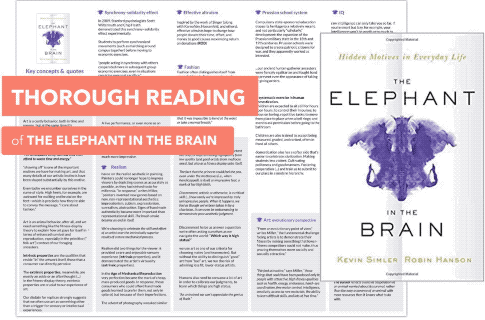Self-directed honesty? If you’ve ever glimpsed the feeling of not being entirely sincere with yourself, especially with things you’d rather not acknowledge, this read may be for you. The discrepancy between what drives us internally and what we display publicly is hardly surprising. But what is most fascinating are the moments when we unknowingly fool ourselves. What guides us, it seems, is the unseen Elephant in the brain – a disturbing, self-deceiving, and usually unacknowledged feature of our minds.
Our worrisome capacity for distorting information helps to misconstrue our motives. The understanding of these phenomena can be quite intimidating, removing the veil of our perceptions to expose our subtle inner-workings.
These are the concepts I found particularly interesting:
On Art:
- The impracticality of Art – with the aim to advertise survival surplus (a fitness display).
- Artistic discernment – as an ability to distinguish good from bad that requires a lot of effort to calibrate judgments.
- Handicap principle – that live performance or unautomated work impresses much more due to a smaller margin for error.
Other aspects:
- Higher standards – virtue shouldn’t transcend our biology or it will become an impossible standard. Goals to strive for and as yardsticks to judge us and others.
- Information – can be sensitive in the sense it can threaten our self and social-image.
- Rationalization – made-up half-truths without any conscious intention to deceive.
- Hill-climbing analogy – a programmed pursuit of higher social status as a hill, that sometimes might be volcano-shaped. A step that feels “up” might knock you down.
- Conspicuous consumption – buying things for the sake of showing off, to flaunt wealth.
- Prussian school system – a compulsory state-sponsored system aimed at obedience and domestication.
On cooperation:
- Mixed-motive games – where two or more players interests overlap but also partially diverge. Overlap creates an incentive to cooperate, divergence makes them somewhat at odds with each other.
- About ego and the mask it lends to us, that once fitted – becomes a new face.
- Synchro-solidarity affect – if you get people acting in synchrony (even by performing silly synchronized moves) they are more likely to cooperate.
- Strategic ignorance – when accurate beliefs are hidden and lead to suboptimal decision-making.
- Cost-benefit structure of conversations – insights into opportunity cost of acquiring information and insight into speech as an act of showing off.
- Humor – as a way to set the mood dial to “play,” binds people and weakens norms.
Perfection as a mark of being cheap – in the Age of Mechanical Reproduction.

